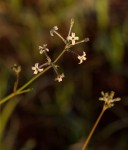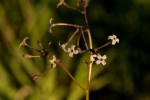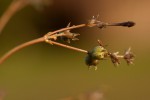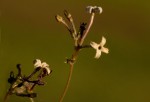| Home | > | List of families | > | Rubiaceae | > | Kohautia | > | caespitosa |
Kohautia caespitosa
brachyloba
Selected images: Click on each image to see a larger version and details of the record View all images (8)
Detailed records: Display species records QDS maps by: Google Maps Point records by Google Maps
Species details: Click on each item to see an explanation of that item (Note: opens a new window)
| Synonyms: |
Oldenlandia lasiocarpa (Klotzsch) Hiern Oldenlandia papillosa K. Schum. Oldenlandia thymifolia (C. Presl) Kuntze Oldenlandia welwitschii Hiern |
| Common names: | |
| Frequency: | |
| Status: | |
| Description: |
Annual or perennial herb 10–80 cm tall with stems sparsely to densely scabrid, papillose or hairy, rarely more or less hairless. Leaves linear to narrowly linear-lanceolate or narrowly lanceolate-elliptic, mostly 14–51 mm long, sparsely hairy or scabrid-papillose above and on margins and midrib beneath, rarely on both surfaces; margins mostly revolute; stipular sheath mostly 1-2 mm long, with stipular lobes 1–5 mm long, occasionally with additional fimbriae on either side. Inflorescences extensive, usually 2 flowers at a node; peduncles 5–95 mm long. Calyx tube ovoid-ellipsoid, 0.7–2 mm long, densely set with papillae; lobes narrowly triangular-lanceolate 0.6–2 mm long. Flowers scented from the evening to early morning; corolla lobes above white, cream, greyish or yellowish, darker beneath; tube 6.5–15 mm long, abruptly widened above; lobes narrowly oblong-lanceolate to very narrowly oblong-elliptic 2.8–7 mm long. Style and stigma shorter than tube; stigma 2-lobed with lobes 1–2 mm long. Capsules subglobose, c. 2.7–5 mm wide, sparsely to densely verrucose or papillose. |
| Type location: |
South Africa |
| Notes: | |
| Derivation of specific name: | |
| Habitat: | |
| Altitude range: (metres) | |
| Flowering time: | |
| Worldwide distribution: | Southern Angola, eastern DRC, southern Tanzania, Malawi, Mozambique, Zambia, Zimbabwe, Botswana, Namibia, Eswatini and, Limpopo, North-West, Gauteng, Mpumalanga, Free State, KwaZulu-Natal, South Africa. |
| National distribution: | |
| Growth form(s): | |
| Endemic status: | |
| Red data list status: | |
| Insects associated with this species: | |
| Spot characters: | Display spot characters for this species |
| Literature: |
Chapano, C. & Mugarisanwa, N.H. (2003). Plants of the Matobo District National Herbarium and Botanic Garden, Zimbabwe Page 23. Da Silva, M.C., Izidine, S. & Amude, A.B. (2004). A preliminary checklist of the vascular plants of Mozambique. Southern African Botanical Diversity Network Report No. 30 Sabonet, Pretoria Page 101. Heath, A. & Heath, R. (2009). Field Guide to the Plants of Northern Botswana including the Okavango Delta Kew Publishing Page 307. (Includes a picture). Kirby, G. (2013). Wild Flowers of Southeast Botswana Struik Nature, Cape Town South Africa Page 105. (Includes a picture). Mapaura, A. & Timberlake, J. (eds) (2004). A checklist of Zimbabwean vascular plants Southern African Botanical Diversity Network Report No. 33 Sabonet, Pretoria and Harare Page 72. Phiri, P.S.M. (2005). A Checklist of Zambian Vascular Plants Southern African Botanical Diversity Network Report No. 32 Page 89. Setshogo, M.P. (2005). Preliminary checklist of the plants of Botswana. Sabonet Report no. 37. Sabonet, Pretoria and Gaborone Page 97. Timberlake, J.R. & Childes, S.L. (2004). Biodiversity of the Four Corners Area: Technical Reviews Volume Two (Chapter 5-15) Appendix 5-1: Plant Checklist Occasional Publications in Biodiversity 15 Page 223. Verdcourt, B. (1988). Rubiaceae, Part 1 Flora Zambesiaca 5(1) Pages 88 - 89. |
Other sources of information about Kohautia caespitosa subsp. brachyloba:
Our websites:
Flora of Botswana: Kohautia caespitosa subsp. brachylobaFlora of Caprivi: Kohautia caespitosa subsp. brachyloba
Flora of Malawi: Kohautia caespitosa subsp. brachyloba
Flora of Mozambique: Kohautia caespitosa subsp. brachyloba
Flora of Zambia: Kohautia caespitosa subsp. brachyloba
Flora of Zimbabwe: Kohautia caespitosa subsp. brachyloba
External websites:
African Plants: A Photo Guide (Senckenberg): Kohautia caespitosaAfrican Plant Database: Kohautia caespitosa
BHL (Biodiversity Heritage Library): Kohautia caespitosa
EOL (Encyclopedia of Life): Kohautia caespitosa
GBIF (Global Biodiversity Information Facility): Kohautia caespitosa
Google: Web - Images - Scholar
iNaturalist: Kohautia caespitosa
IPNI (International Plant Names Index): Kohautia caespitosa
JSTOR Plant Science: Kohautia caespitosa
Mansfeld World Database of Agricultural and Horticultural Crops: Kohautia caespitosa
Plants of the World Online: Kohautia caespitosa
Tropicos: Kohautia caespitosa
Wikipedia: Kohautia caespitosa
| Home | > | List of families | > | Rubiaceae | > | Kohautia | > | caespitosa |







